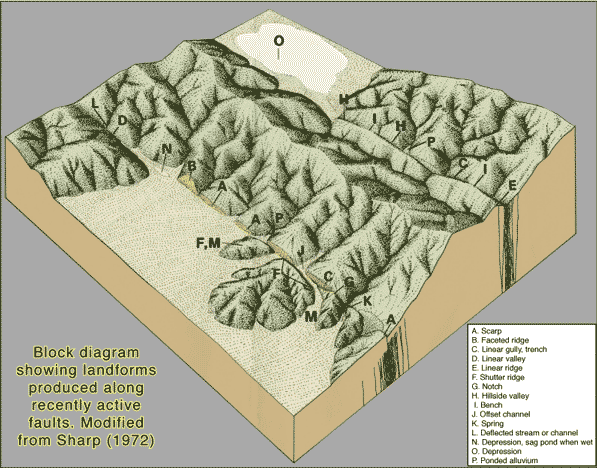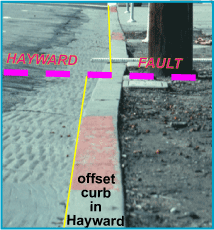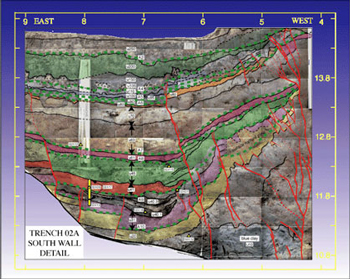
Three types of observations are used to determine the location of the fault and indicate recency of movement. Each of these is labeled on the map in a different color.
G - Geomorphic evidence
The Earth's surface is transformed by movement along active faults, producing features that help us determine the location of the fault and are diagnostic of the fault's level of activity. Examples are provided in the block diagram below.

C - Creep evidence

Creep is steady fault movement, varying from continuous to episodic with creep events lasting minutes to days. Generally creep occurs without any associated earthquake activity (i.e., aseismic). Creep has been monitored on the Hayward fault for forty years (Lienkaemper et al., 2001) and is also observed along some sections of other faults in the San Francisco Bay region, including the San Andreas, Calaveras, Concord-Green Valley and Maacama (Galehouse and Lienkaemper, 2003). Locations on the map showing creep evidence are indicated by green circles.
The depth of creep varies, from as little 2 miles deep in northern Oakland to as deep as 7 miles near the northern and southern ends of the fault. Unfortunately, this means the lower, brittle fault zone remains largely locked (i.e., it's not creeping), so it is building strain which can only be relieved by major earthquakes, which occur about every 100 to 200 years. The average recurrence time for earthquakes is determined by paleoseismologists, geologists who work in trenches across the faults. They document evidence of paleoearthquakes recorded in sedimentary layers, using radiocarbon analysis to date them.
T - Trenching evidence
Locations of trenches are shown on the maps as thin blue lines and each is labeled using codes (T) and abbreviated descriptions of the evidence found in the trench.
Most trenches across the Hayward fault were excavated to meet the requirements of the Alquist-Priolo Earthquake Fault Zoning Act, to insure that structures are not built over active fault traces. Other trenches have been used by scientists to learn about the fault's capability as a source of earthquakes. Earthquake geologists probe in to the fault's past behavior using the tools of paleoseismology.


 Jump to Navigation
Jump to Navigation